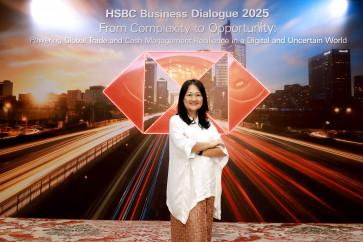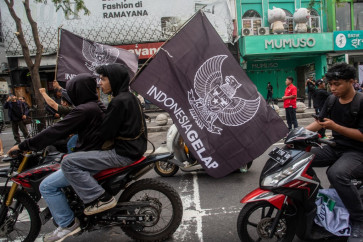Popular Reads
Top Results
Can't find what you're looking for?
View all search resultsPopular Reads
Top Results
Can't find what you're looking for?
View all search resultsNeophyte designers sense thirst for threads in nouveau riche
Designing soles: Spotting opportunity in the strengthening purchasing power, emerging designers are feeding the fashionably ambitious middle class with edgy wardrobe pieces, including accessories, that come with equally fancy price tags
Change text size
Gift Premium Articles
to Anyone
D
span class="caption" style="width: 378px;">Designing soles: Spotting opportunity in the strengthening purchasing power, emerging designers are feeding the fashionably ambitious middle class with edgy wardrobe pieces, including accessories, that come with equally fancy price tags.The latest crop of emerging talents in ready-to-wear fashion are far from shy, exuding confidence through their sartorially chic style and price tags to show the evolving trends within the growing middle class.
Yenda Handriaman, together with business partner Sulung Koesuma, crafts men’s leather footwear under the brand Pvblic Affairs. The shoes are clearly made for middle-upper class shoe aficionados as they are consigned to boutiques in upper-end malls and carry price tags from Rp 1.3 million (US$143) to Rp 1.8 million.
“The shoes are markedly more expensive than other local brands,” Yenda pointed out. He added that the brand chose to target men in this segment because “they are the people who are willing to spend their time and money on select goods”.
Indonesia has a middle class population exceeding 131 million, with upper-middle class people spending higher that US$10 per day on average, a World Bank study published last year showed. This thriving middle class contributed significantly to domestic consumption, which accounts for more than 60 percent of GDP.
Given the drive to consume, Pvblic Affairs has experienced a multi-fold increase in sales, from 48 pairs within the first months of their market entry in 2010 to the current 400 pairs, he added. He further said that their collection of boots, which cost up to Rp 1.8 million, were their best-seller.
Budding brands in men’s fashion are not the only ones gaining from the shopping zest of the middle class.
Windy Dana, who established the Antyk Butyk accessory brand last year, said that targeting the middle class for business was “fabulous” because they “know what they want”. Windy hand-makes accessories, including necklaces from a variety of materials, such as traditional cloth and semi-precious stones.
“They are impulse buyers,” she said, adding that this made them more flexible in spending.
A study by Nielsen in 2011 found that the rapidly rising middle class was more inclined to spend on improving their well-being through better comfort and lifestyle. However, this segment comes with drawbacks. Buyers lacked appreciation towards quality, choosing cheap knock-offs over more expensive yet hand-crafted items made of quality materials.
The Nielsen study found that households still spent a majority of their income — 37 percent to be exact — on food.
Consequently, Windy said that she had to limit the use of the stones to suppress prices below Rp 250,000, a far cry from the A$80 her creations were sold for when she was still living in Australia.
“People here have not come to appreciate design,” she told The Jakarta Post. Yet, the future still looks filled with potential for local independent brands as more weave their way into the promising market.
The World Bank announced last year that in the previous seven years, as many as seven million Indonesians entered the lower-middle income group; those spending US$2 to $20 per day.
Agra Satria, of the G.H.O.S.T accessory line, said that the slew of media publications and events supporting up and coming local designers have built the affinity of customers towards local brands.
“People are starting to mix their branded items with those from independent brands, making their style more eclectic,” he told the Post. He added that crafting well-designed and individual pieces were essential for local designers in order to nurture niche markets.
G.H.O.S.T, which recently won an award for “most promising accessories brand”, boasts a collection dominated by eye-catching acrylic pieces, some resembling Soviet-like insignias, dangling from generous strings of pearls. However, he did admit those who bought the hand-made collection, whose pieces fetch as much as Rp 1.2 million, inevitably hail from the middle and upper class. Yet, emerging fashion brands are tapping into more than consumers’ pockets. They are ultimately appealing to their customers’ sense of self.
Yenda pointed out that the target market of their shoes was not based so much on youth than on character.
After all, around 60 percent of the population is aged 39 years and younger. “They do not want to look the same with the rest of the office,” Yenda said. “They are men with character and are passionate about shoes.”
Agra said that, although production has increased from 36 pieces during their start around 2008 to roughly 200 pieces last year, they continue to regulate the number of items that hit stores to maintain design exclusivity.
“We do not favor mass produced goods and we apply this to our collection. We want people to feel special by having one-of-a-kind pieces,” he told the Post. He added that his niche was essentially people who were “bold, likes quirky stuff and appreciated design”.
“These people, who are appreciative of design, are not very concerned about price,” he noted.
Klé, a local women’s ready-to-wear brand, also appealed to the desire of the to sartorially stand out.
The collection, which includes T-shirts and trousers, could cost up to Rp 1.5 million for unique pieces the label printed themselves.
She said that the unique creations gave the label, which can be found at high-end malls in Jakarta, an edge over international brands that have washed over the market. “This is a market with a strong need to be fashionable and is on the lookout for something different,” she said.










